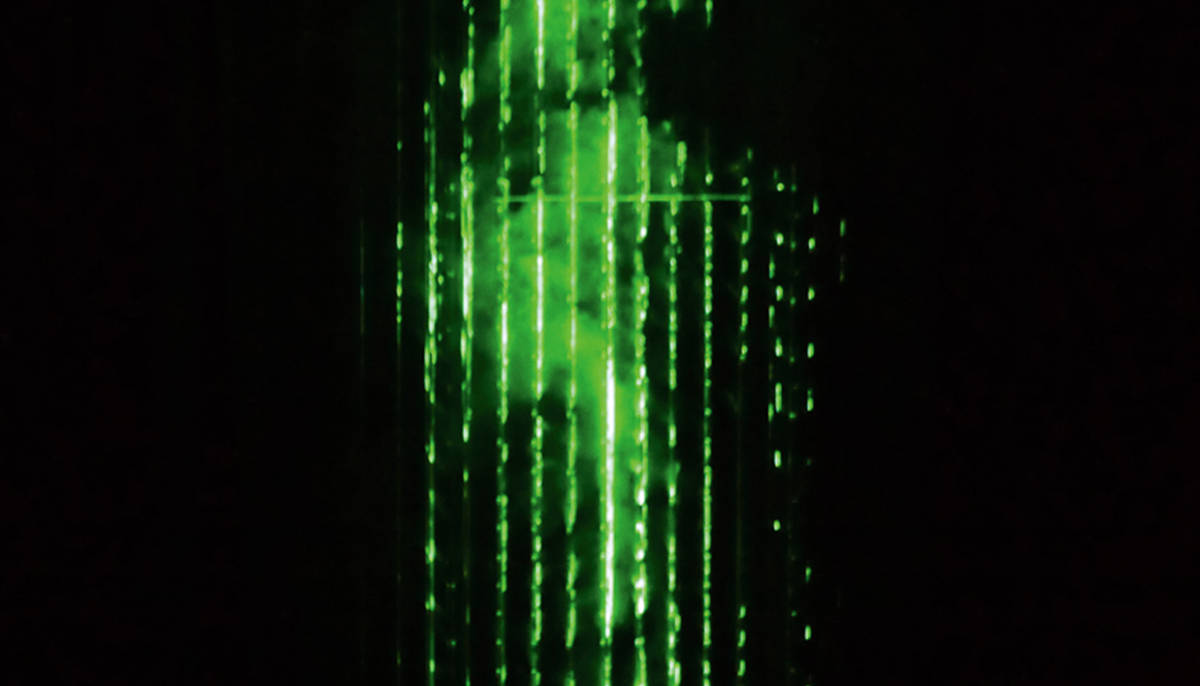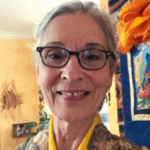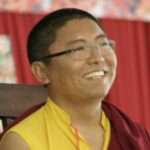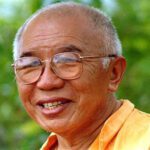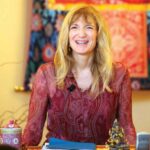Recognizing Our True Nature
by Margarita Loinaz
It was early morning at the turn of the millennium, and I was in San Miguel de Allende, Mexico, with a sangha friend for a week of rest from our demanding work. On a little shelf on the wall of my bedroom, I had placed a picture of my root teacher, Kalu Rimpoche, which I always traveled with. While I was still in bed, the thoughts began to form: I will brush my teeth, light some incense, and sit. Suddenly, wayward thoughts came through: Why do you have to brush your teeth? Why do you need to light incense? Why not just sit?
From some deeper knowing, I’d realized that all the content in my mind was made up, all based on conventions and determined by the culture I was embedded in. I felt my whole conceptual scaffolding fall down. I was left with a profound openness, without content, yet filled with the deepest peace, wonder, tenderness, and vulnerability. I completely lost all sense of time. For the remainder of that week, I continued to be filled with awe and wonder, unable to do much of what was planned.
On a visit to a pink stone cathedral built by indigenous people, I watched an elderly indigenous man come in to pay respect to the Virgin. He knelt on one knee and bent his whole body forward in a bow of surrender and reverence that seemed to offer everything, with nothing held back. My heart was deeply touched and I recognized how this level of surrender and devotion made a new stage of practice possible. It then took me four years to find my precious Dzogchen teacher.
Dzogchen (Dzogpachempo/Great Perfection/Ati Yoga) is a tradition of teachings within the Nyingma lineage of Tibetan Buddhism. Its teachings are centered on the direct recognition of our intrinsic timeless, nonconceptual awareness, which lies beyond the intellect and its frameworks. This is referred to as “The View.” This recognition is most often brought about by an accomplished teacher pointing it out to the student. This “pointing out” can happen in many different ways. It may be done through specific instructions, symbols/gestures, or mind-to-mind transmission. We may be instructed to look directly at our mind, noticing that behind the thoughts, there is an empty cognizance that is timeless, pervasive, and lucid. Or the teacher may say a word, make a gesture, or hold an object that suddenly opens the view. It may also happen by being in the presence of a realized teacher whose field of timeless awareness is so powerful that there is a mind-to-mind transmission for students whose devotion opens the door.
Most of us live within the confines of our identity as a discreet, separate self that is desperately trying to stabilize its own existence. However, we all carry the natural freedom of our essential nature, though unrecognized. As expressed at the beginning of the Heart Sutra: “Indescribable, inconceivable, and inexpressible, the perfection of sublime knowing is unborn and unceasing—the very nature of space. It is the realm of your own self-knowing, timeless awareness.” With sublime knowing, we intellectually go through the process of understanding the empty nature of things. The perfection of sublime knowing, however, requires that we are grounded in the direct experience of our primordial, nonconceptual nature. Unlike the gradual process of our development practices, Dzogchen is a direct approach into our intrinsic nature, which is sometimes referred to as “the natural state.” Once we are introduced to this recognition, the practice itself is to sustain it as much as possible in order to gain continuity and stability.
At first, most of us experience only brief moments of this awareness and may feel discouraged. However, continuing to prioritize this recognition, we begin to learn which conditions support it and which do not. As we gain more continuity, insight manifests at deeper and more subtle levels, and we can experience how this timeless awareness functions as cognition and appropriate actions. As our practice matures, the separation of object/subject begins to soften, and we may feel ourselves in the unobstructed flow beyond duality.
It is said that the freedom found through the Dzogchen teachings goes beyond samsara and nirvana as we cut through the solidity of ordinary perception. Integration of this wisdom with our everyday lived experience presents new levels of understanding and healing. In teaching and leading study groups within the BIPOC community, these teachings have been invaluable to me. When we deeply understand how the social structures we are embedded in negatively impact some of us disproportionally, a new level of compassion arises. Recognizing buddhanature as the intrinsic core of what we actually are allows us to meet our lives beyond the confines of what the ordinary mind could ever imagine.
Guided Practice
First find a comfortable position where you can be relaxed, yet alert. The entirety of this precious human body is the instrument of perception that Awakened Mind has to experience itself through physicality. Many of us have taken in negative feelings about our bodies from the cultures we live in, which become obstacles to practice. As a preliminary step to recognizing our intrinsic nature, we can tenderly take time to appreciate the miracle of these human bodies and their inseparability from the earth and the natural world.
Do the following slowly, at a pace that allows each area of your body to relax.
1) Using your hands with the tenderness of an ideal mother toward her precious child, begin by holding your head, appreciating the amazing organ that is our brain, which works so hard to keep us safe and optimize our situation. Next, move the hands over the eyes, usually so busy reaching for external objects; over the ears, which allow us to hear birdsong and music as well as difficult sounds; the nose, which allows us to register scents and contributes to taste; the mouth, which allows us to speak, kiss our loved ones, and take in nourishment; the vulnerable neck, which carries so many different structures, including our voice box; our arms and hands, which allow us to perform intricate functions and embrace loved ones; our precious lungs that are in reciprocal relationship with the plants, taking in oxygen that they produce as the plants, in turn, use the CO2 we exhale; the heart, which sends blood throughout our bodies and is the energetic center that guides our empathy and ethical conduct; our bellies, which house organs of digestion, elimination, and reproduction.
2) Tuning into the bony bowl of our pelvis and the long bones of our thighs and legs, which are the densest parts of our bodies and have minerals that are similar to those of the Earth itself, feel how the whole structure registers gravity and holds the shape of the body. Appreciate the precious feet that carry us through a whole lifetime.
3) With the entirety of the body lit up under your loving gaze, feel the dynamism present and turn your attention to this mind, the mind that is experiencing this meditation. As you look into the mind, notice the empty, spacious field without boundary within which all thoughts and sensations arise and fade. Notice that it is a field of nonconceptual awareness, a naked, lucid sky of wakefulness.
4) As you relax back into this field of awareness, notice how it becomes pervasive, permeating the entirety of the body and all phenomena. Allow thoughts and sensations to come and go in their own time while continuing to recognize yourself as this sky of wakefulness. Sustain this for as long as it feels fresh. Open to the blessings and guidance that arise, and dedicate the merit to the freedom of all!
Recognizing Clarity
by Tsoknyi Rinpoche
The approach to cutting our ties to samsara in the Dzogchen and Mahamudra meditation traditions of Vajrayana Buddhism is to allow samsara to manifest and immediately recognize that it is the expression or display of primordial wisdom.
In Dzogchen practice, the most important thing is the recognition of inner space or emptiness. If you can practice this, then whatever phenomena of samsara arise are dissolved into wisdom mind. For this to happen, your recognition of mind nature has to be unwavering. If you can achieve this, then anything that arises in your mindstream—any emotions, thoughts, likes, dislikes, perceptions of good and bad, and so on—is naturally released without effort.
The problem is, when phenomena arise from confusion and ignorance, they dominate your perception and result in suffering. However, habitual negative emotions like fear can be naturally liberated by allowing them to dissolve into the inner space of mind. You can do this because the essence of these habitual emotions is actually wisdom.
The key point is to let go of the grasping within the emotion and see its true nature. When habitual emotions arise, you neither suppress nor get caught up in them. You do not get carried away by clinging to self and other. If you just allow the emotion to dissolve, the energy trapped within it is released and blossoms as wisdom.
With continued practice in the true nature of mind, you can develop strong self-knowing awareness so that it naturally alchemizes negative emotions into their essence. When phenomena arise, they are self-liberated because your ego identity and conceptual mind have finally retreated. Then the true nature of mind, which is wisdom, lets them resolve into inner space naturally.
In Dzogchen, this is called the “great ease,” in which even the concept of death is a joke, just another phenomenon that is ultimately empty. You have gone through a secret door of sorts: everything that was hidden from you by conceptual mind and ego fixation is revealed. You realize it has been completely accessible and present all the time as your basic nature.
True mind nature does not act, do anything, modify, or function as some subtle antidote to phenomena. It is simply open space and luminosity in union. If you throw colored chalk powder into the air, it has nothing to hold onto or cling to. It naturally falls to the ground. It is not like space does anything. It is simply how space is. The true nature of mind is like that.
When you reach this last level, everything that arises is perceived as friendly, and you are completely carefree. You do not need to accept, reject, or change anything. All appearances are realized as pure wisdom phenomena, arising spontaneously as compassionate energy from the unity of absolute and relative truth.
This natural liberation of thought and emotion is based on a non-conceptual recognition of inner space. You know that the essence of any afflictive emotion is pure wisdom and that thoughts in themselves are empty. This gives you a deep sense of spacious ease, a carefree feeling. You have confidence that all phenomena can be naturally released by themselves without the necessity of an antidote or remedy. You experience the infinite purity that pervades everything. You do not need to eliminate or abandon anything since it is already pure in essence.
Guided Practice
Clarity is the capacity to recognize and distinguish the unlimited variety of thoughts, feelings, sensations, and appearances that continually emerge in the mind. It is also called luminosity. Without clarity, we wouldn’t be able to recognize or identify any aspect of our experience. To recognize clarity, do this meditation practice using a physical object as the focus of your attention.
1) Rest for a few minutes in open presence.
2) Turn your attention to an object on which you’ve chosen to focus. I advise using a physical object that is clear and transparent, like a glass.
Thoughts, feelings, and judgments about the object will almost inevitably arise: “This is pretty.” “This is ugly.” “This is—I don’t know—it’s just a glass.” You may even wonder, as I did many years ago when I was first taught this practice, “Why am I doing this?” The point of the practice lies in the next step.
3) After focusing for a few moments on an object, turn your attention inward. Focus on awareness that perceives not only the object, but also the thoughts, feelings, judgments surrounding it.
As you do so, a very gentle experience of what many of my teachers called “awareness of being aware” emerges. You’ll begin to recognize that whatever you see, however you see it, is accompanied by emotional and cognitive residue—the stuff that remains from being a neglected child, a failure in the eyes of parents or teachers, the victim of a schoolyard bully.
When we turn our awareness inward, we begin to dismantle the images we hold about ourselves and the world around us. In so doing, we begin to see how past experiences turn into present patterns. We glimpse the possibility of a connection between what we see and our capacity to see.
Recognizing Buddhanature Through Tonglen
by Lama Palden Drolma
Connecting with our buddhanature, our enlightened nature, often feels very far away, like it’s not even possible. But it is much closer than we think. For example, when we are suddenly moved to compassion for someone, right then our buddhanature is shining through us. If we tune into ourselves at that moment, we can feel our innate goodness, our unconditioned pure being. Or when someone looks at us with complete love, we can allow it in and feel the same.
Tonglen, which means taking and sending, is a meditation practice that cultivates unconditional compassion and love. In Tonglen, as we open to our own or others’ suffering and allow it to be transformed into compassion, we awaken to the compassion and love that is at the core of who we are. We first bring loving awareness to ourselves, and then we exchange self for others. Taking and sending for ourselves can unearth feelings of self-hatred, low self-worth, deficiency, and unworthiness, among others. As we gradually work through these feelings and open to increased kindness and compassion for ourselves, it helps heal our core wounds and loosens our self-fixation, facilitating a deeper opening into compassion and love.
When we engage in taking and sending with others in mind, we start with those we love, then move on to those we like, those we naturally feel compassion for, and those we feel neutrally about. This shifts the dynamics between ourselves and others. Then we move into working with those we dislike and, finally, those we find particularly challenging. Doing Tonglen for people we dislike or who are hurtful can bring up feelings of anger, frustration, disappointment, and sorrow. Again, we work through these feelings as much as possible. In time, we can develop compassion for difficult people in our lives through realizing the causes, conditions, and ignorance that have led them to their actions. (This is not to say that their actions are excused. People can be held accountable, and compassion can be present simultaneously.) Through all of this, we can eventually have compassion for all beings and ourselves equally. As our hearts open, we connect directly with our buddhanature.
The Tonglen that my teacher, the previous Kalu Rinpoche, transmitted comes from the fully enlightened wisdom dakini Niguma, an eleventh-century woman from Kashmir. This extraordinary form of Tonglen has additional elements which further assist us in opening to our buddhanature. In it, we pray to the bodhisattva of compassion, Chenrezig (Skt. Avalokitesvara), for our love and compassion to fully blossom. Chenrezig, who embodies all the Buddha’s awakened love and compassion, then dissolves into us, and we become inseparable from him. This helps shift us out of ego consciousness into awareness.
When we let everything in, the taking and sending dissolve into emptiness. We let go of the doer, we let go of anyone to do anything for, and we let go of anything to be done. This is nondual wisdom. We let our minds rest in openness, inseparable from the love and compassion that has been cultivated. In this way, we open further to our buddhanature.
Guided Practice: Extraordinary Tonglen Meditation in Eight Steps
1) Rest in Open Awareness.
Meditate with your eyes open, soft gaze.
2) Awakened Sanctuary
Call on the buddhas and bodhisattvas, the awakened sangha, the dharma, and your own teachers to be present with you. They arrive quickly and sit in the sky in front of you.
Take refuge and request transmission from the awakened beings. Open to a sense of connection, sanctuary, and transmission.
The refuge beings dissolve into you, and you become inseparable from them.
3) Cultivating and Uncovering Bodhicitta—Altruism
Cultivate the wish to awaken in order to completely free others and yourself from suffering. Think that you are engaging in meditation on behalf of all beings.
4) Stepping into Love
Call upon Chenrezig, the bodhisattva of compassion and embodiment of all the Buddha’s awakened love. Pray to him for your innate love and compassion to be fully actualized.
Imagine Chenrezig dissolving into yourself. Feel that you become inseparable with awakened compassion and love and now appear as a body of light, as Chenrezig.
A small Chenrezig with a diamond vajra of light in his heart appears in your heart chakra. The vajra radiates out love as five-colored light to all beings.
Chant the mantra of compassion, Om Mani Padme Hum.
5) Begin Taking and Sending with Yourself
As Chenrezig, imagine your ordinary self in front of you, facing you. Open to feeling any suffering that is present in yourself, and generate loving-kindness and compassion for yourself.
Breathe in the suffering as black smoke into the vajra in your heart. As soon as it touches the vajra, a lightning bolt emerges from the vajra, instantly transforming the suffering into white light, which is awakened love and healing energy.
Breathe out the white light into the self in front of you. See the light filling your ordinary self, bringing compassion, love, and awakening.
Optionally, after doing Tonglen for yourself, contemplate all those who are suffering in a similar way, and think, “Oh, just like me, many people suffer in this way! By my suffering, may all those suffering from this be freed from this pain.”
6) Taking and Sending for Others
Imagine in front of you the person or people you want to work with. Contemplate their suffering and generate loving-kindness and compassion for them.
Breathe in their suffering as black smoke, and see it instantaneously transformed by the lightning bolt emanating from the vajra. Continue the Tonglen as above.
Gradually extend your meditation to include all beings, imagining them in front of you. Finally, imagine everyone filled with white light, healed, completely awakened. Rest in this.
7) Dissolution
Let all you have engaged with dissolve into space and openness. Rest in awareness naturally.
8) Dedication
Dedicate any and all benefit of your meditation to all beings’ happiness and liberation.
Recognizing Mind Essence
by Tulku Urgyen Rinpoche
The only way to acquire all the great qualities of Enlighten-
ment is to repeat many times the short moment of recognising
mind essence.
There is no other method.
One reason for short moments is that, as there is no stability right now, the recognition of awareness doesn’t last for more than a brief moment, whether we like it or not.
By practicing many times, we get used to it.
—From Vajra Speech, published by Rangjung Yeshe Publications.
